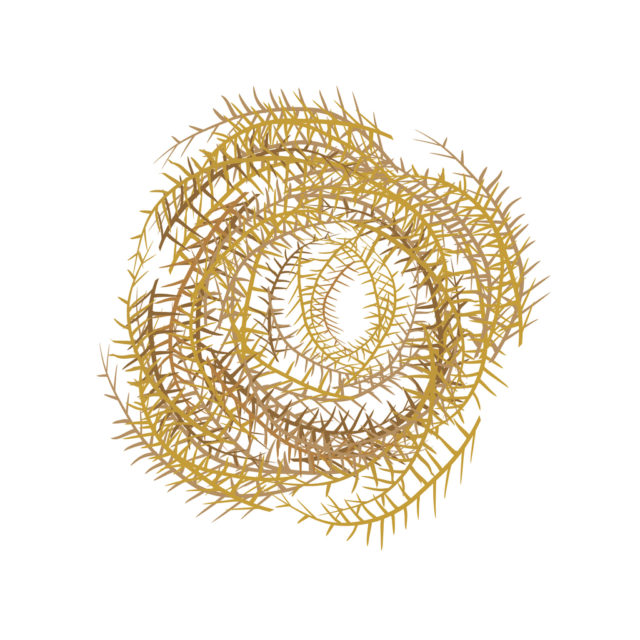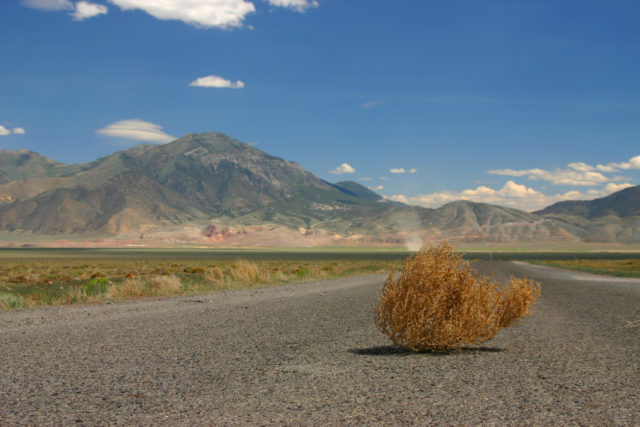It’s a favorite image: A tumbleweed rolling over and over in the wind down a lonely, dusty dirt road flanked by wood-planked porches and swinging saloon doors. You might hear horses hooves clopping nearby, maybe a distant ricocheting gunshot. Cue the Ennio Morricone music that swelled in Sergio Leone’s famous spaghetti Western movies. Nothing more symbolic of the late 1880s Wild West than the tumbling tumbleweed, nothing more American, right?
Nyet!
The tumbleweed is actually Russian thistle, and it is not a plant native to North America. The invasive Russian weed arrived in the 1870s in Bon Homme County, South Dakota, in a shipment of flax seeds brought over by Ukrainian farmers. Within 20 years, the peripatetic plant had wandered from California to Canada, and today it can be found in every state except Florida and Alaska. It is also abundant in the Ural Mountains in Russia, as well as South Africa, Argentina, Japan, and New Zealand, among other far-flung countries.
In the 1890s, the U.S. Department of Agriculture was so alarmed by the rapid spread of the weed that it sent a botanist to investigate, according to National Geographic. “The rapidity with which the Russian thistle has spread, both in infesting new territory and in thoroughly covering that already infested, far exceeds that of any weed known in America,” wrote the botanist, Lyster Hoxie Dewey.
Tumbleweed exhibits some of the scrappy characteristics of the cowboy life it symbolizes: It ranges widely, thrives in disrupted territories like agricultural fields, irrigation canals, and roadside shoulders, and can easily exist in a diverse range of altitudes from below sea level to 8,500 feet. No wonder it loves the West!

The Russian thistle’s Latin name, Salsola tragus, derives from sallere, or salt, referring to the plant’s salt and heat tolerance, which is why it thrives in the arid climates of the West. An annual bush, it breaks off in the fall or winter, looking like the skeleton of a dead plant. It can be as small as a grapefruit or as big as a Fiat. As it rolls down a road, a Russian thistle plant flings off its seeds, which typically number 250,000 per plant.
But you might not recognize the tumbleweed in the spring and summer, when it is young and green. Then it is covered in grass-like shoots striped with purple or red, and tiny flowers in the crooks of the shoots. Mammals like mice and bighorn sheep eat tumbleweed, and in fact, in this tender state, tumbleweed is edible for humans too, raw or sautéed in oil and garlic.
While it symbolizes loneliness, tumbleweed en masse can be a menace. In fact, one town found itself literally choked by the weed in January 2014. A massive windstorm blew thousands of tumbleweeds into Clovis, New Mexico, so much so that it completely covered gas stations, parking lots, and front yards, trapping people inside their homes. “It had to be at least eight feet high,” a resident told the local news station.

It also has its place in humor. In the 1990s, Linda Katz of Garden City, Kansas, set up a website selling tumbleweeds, as a joke. But people bought it, literally, and at one point she reportedly made as much as $40,000 selling the weed to such customers as the set designers of “Barney and Friends,” Ralph Lauren stores, and NASA, according to the Kansas Hutchinson News. What’s more American than that?
The Russian thistle might be the most cinematic weed, but it is not in fact the most invasive species in the U.S. The Smithsonian lists the top six invaders as purple loosestrife, Japanese honeysuckle, Japanese barberry, Norway Maple, English Ivy, and kudzu. And the invaders are gaining on the natives. A 2014 study out of the University of Massachusetts, Amherst, found that invasive plants are more widely distributed across the U.S. than native plants.
